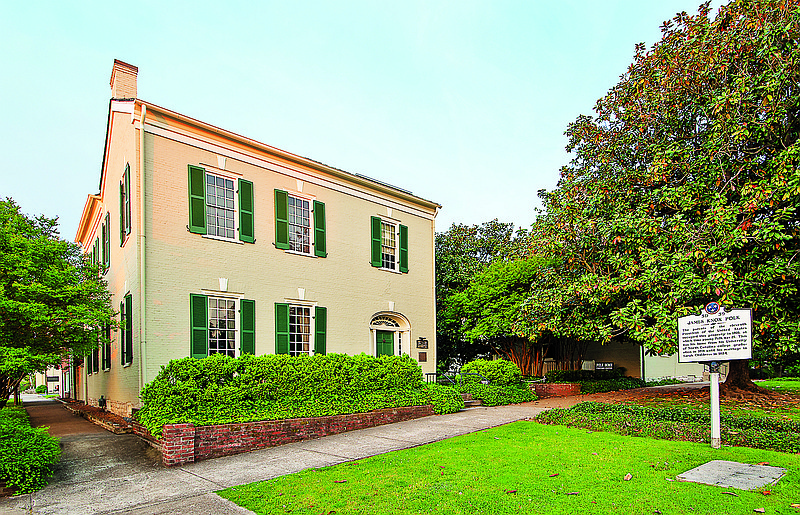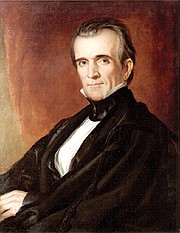Photo Gallery
Preserving History/Polk Home Being Studied For Possible Inclusion in National Park System
COLUMBIA, Tenn. - Visitors to the President James K. Polk Home & Museum here learn quickly that the 11th president and former Tennessee governor worked hard, aged greatly while in office and fulfilled every one of his campaign promises - including a pledge to serve just one term in the White House.
Several of Polk's accomplishments compare favorably with presidents of the United States in recent years, but the former Tennessee congressman is often characterized as the "forgotten president," visitors to the family home in Middle Tennessee learn.
If you go
' What: James K. Polk Home and Museum ' Where: 301 W. Seventh St., Columbia, Tenn. ' Hours: 9 a.m.-5 p.m. Monday-Saturday and 1-5 p.m. Sunday (April-October) and 9 a.m.-4 p.m. Monday-Saturday and 1-5 p.m. Sunday (November-March) (All times Central). ' Admission: $10 adults, $8 seniors, $7 youth, $5 children, free for children 5-under. ' Phone: 931-388-2354. ' Website: www.jameskpolk.com.
He died a few months after serving his only term in office (1845-1849) at age 53. Within a decade, the country would become embroiled in a bitter civil war.
Few people know that while in office, Polk re-enacted an independent treasury system, issued the first postage stamp, oversaw the founding of the U.S. Naval Academy and signed the act creating the Smithsonian Institution.
U.S. Sen. Lamar Alexander, R-Tenn., can't do much about Polk's place in history, but he believes the home where Polk lived between 1816 and 1823, the only Polk home other than the White House still standing, should be elevated to "the national treasure it deserves to be."
The home is in downtown Columbia, about 45 miles south of Nashville and 150 miles from Chattanooga. It sits on tree-lined Seventh Street, which features many beautiful and larger homes but none with the Polk home's historical significance.
To help maintain that significance, Sen. Alexander recently introduced legislation requesting the Department of the Interior take the next step in preserving the home, which receives 10,000-12,000 visitors each year.
That step, the James K. Polk Home Study Act, comes on the heels of a 2013 letter to the director of the National Park Service requesting a survey to determine the home's significance and sustainability as a unit of the National Park System.
In April, the survey found the home is nationally significant and could meet the criteria for inclusion in the National Park System.
John Holtzapple, executive director of the James K. Polk Home and Museum, said the finding "is the first step in a long process."
"We're grateful [the National Park Service is] interested," he said, "and we're grateful to Sen. Alexander for his interest in this."
Once the resources study is complete, findings and recommendations will be submitted to the Committee on Natural Resources of the House of Representatives and the Committee on Energy and Natural Resources of the Senate, of which Alexander is a member.
The home is owned by the state of Tennessee and partially funded under an agreement with the Tennessee Department of Environment and Conservation/Tennessee Historical Commission. It is operated by the nonprofit James K. Polk Memorial Association.
That association was founded in 1924 by a great-great-niece of of Sarah Childress Polk, the president's wife, according to Holtzapple. She had passed down many items from the Polks, who were childless, and she wanted to display them. But when she became engaged and planned to move to New York City, she had no place to put them and so, with several friends, founded the association.
The items were displayed at several locations in Nashville for a few years, but then the former Polk home in Columbia went on the market in 1929. The association didn't have the funds to buy it, so it petitioned the state, which purchased the home. Additional state purchases in 1937, 1941, 1953, 1961 and 2015 expanded the complex, and the Memorial Association purchased and renovated a church on the same block into a state-of-the-art exhibit facility in 2009.
Holtzapple said the state offers help with expenses such as a new roof, gives the association an annual grant and occasionally provides special allocations like a current $150,000 one for lighting and walkways. However, he said nonprofit groups cover 89 percent of the day-to-day operation.
Tiny Jones, a former president of the Polk Association and current board member, said a conversation several years ago among Alexander and board members at the Polk home got the ball rolling for National Park Service assistance.
"It's getting harder and harder to keep the doors open," she said. "It's a gem for Maury County to have this home here. But we realize there is so much more we could and should do to raise our national profile and reach a wider audience. And those plans require increased financial support."
The National Park Service tie-in could be ideal, Alexander said.
"Columbia's dedicated residents are making progress," he said in a news release.
Though the home is on the National Register of Historic Places and is a National Historic Landmark, it is the only one of three Tennessee presidential sites not to have a federal tie-in. Andrew Johnson's home in Greeneville is a National Historic Site and is fully run by the National Park Service. Andrew Jackson's home in Nashville is a partner with the National Trust for Historic Preservation but is run by a private nonprofit association, the nonprofit Andrew Jackson Foundation (formerly the Ladies Hermitage Association).
THE HOME
The Polk home, at the corner of West Seventh and High streets, actually never belonged to the 11th president. It was built by his father when Polk was 21 and a student at the University of North Carolina. However, the younger Polk lived there between the time he graduated from college as the school's salutatorian and when he married Sarah Childress in 1824.
It was passed down through three of the president's brothers, then out of family hands in 1862.
Polk, who also had been governor of Tennessee (1839-1841), purchased a home on Vine Street in Nashville, which was to be his post-presidential residence, but he died of cholera only three months after leaving office. His widow lived in the home, which came to be known as Polk Place, until her death in 1891. It was demolished in 1900, and the space is now occupied by a Best Western Hotel.
Today, the Polk home - built in Federal style - contains more than 1,400 artifacts, including original pieces, items from Polk's law office down the street, pieces from Polk Place and articles from the Polk White House.
Among those are a White House grocery account book, where it was noted one bushel of corn meal cost 85 cents and six pounds of butter $1.38; his notification as election of president; Sarah Polk's childhood pianoforte; his smoking jacket (his only piece of clothing to survive); and a 200-year-old copy of a 500-year-old portrait of Hernan Cortes given to him as the second man (following Cortes) to conquer Mexico.
The complex also includes a second family residence, known as the Sisters' Home, a detached period kitchen, landscaped gardens and garden cottage and the Polk Presidential Hall, which is a renovated church.
The Polk home, docents explain, was one of the most prominent in town when it was built and reflected the relative wealth of the president's father, Samuel, who was a farmer, land surveyor, mercantile store operator and plantation owner.
Yet, the two-story home has only five large rooms - a living room and dining room on the first floor and a master bedroom, boys' bedroom and girls' bedroom on the second floor.
Polk's legacy as the oldest of 10 children is explained by guides as well as his precarious surgery for bladder stones at 17, his friendship with President Jackson, his acquisition of 1.19 million acres for the United States (Texas, California and the Oregon territory) and his death from highly contagious cholera.
Also highlighted are his presidential firsts: only former Speaker of the U.S. House of Representatives to be elected president, first to have "Hail to the Chief" played and first to sit for a White House daguerreotype, among others.
Also during his tenure, the Mexican War was fought, the Washington Monument was commissioned and the Department of the Interior was created.
Polk's wife, Sarah, is not forgotten, either, with docents mentioning her role as her husband's chief adviser, her friendship with former first lady Dolly Madison, her wildflower-pattern White House china (including matching chamber pot) and her never-changing black attire during her record 42 years of presidential widowhood.
Contact Clint Cooper at ccooper@timesfree press.com or 423-757-6497.

